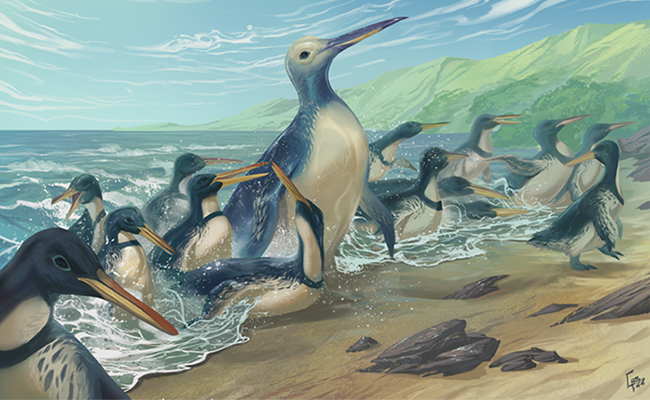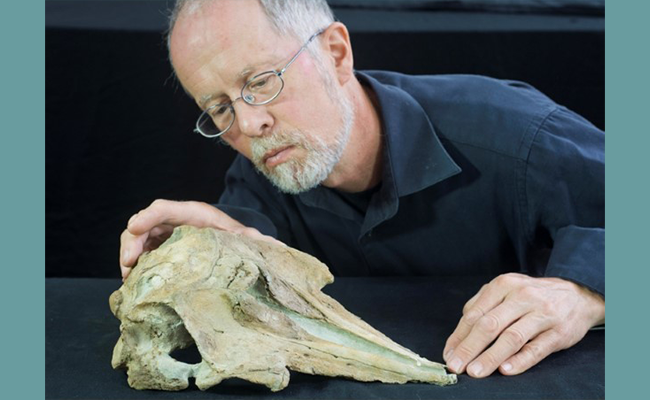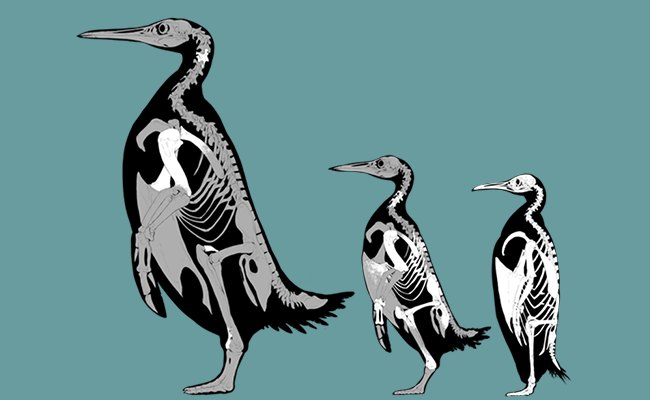
Life reconstructions of Kumimanu fordycei and Petradyptes stonehousei, by Dr Simone Giovanardi.
The world's largest penguin has been named in honour of Emeritus Professor Ewan Fordyce, recognising his enormous contributions to marine vertebrate paleontology.
Study lead author Dr Daniel Ksepka, Bruce Museum Curator, says the 150kg Kumimanu fordycei is a new species collected from the Otago region.
He and a team of international researchers have just published a study in the Journal of Paleontology outlining the discovery and study of the fossil, as well as another new extinct penguin species Petradyptes stonehousei.
The fossils were discovered in 57-million-year-old beach boulders in North Otago by Museum of New Zealand Te Papa Tongarewa Curator Alan Tennyson between 2016 and 2017.
Dr Ksepka says the researchers are “thrilled” to name one species after Emeritus Professor Fordyce in honour of his vast contributions to paleontology in general and to fossil penguins in particular.

Emeritus Professor Ewan Fordyce has had a penguin named after him.
“I've personally known Ewan since 2006, when he kindly hosted me as a visiting student. We have published a few papers over the years and our 2012 paper on the fossil penguin Kairuku was the most enjoyable project of my career.
“He is simply a legend in the field, for his discoveries, papers, mentoring, and storytelling,” he says.
Kumimanu and Petradyptes show that penguins got very large early in their evolutionary history, millions of years before they fine-tuned their flipper apparatus.
The team observed the two species retained primitive features such as more slender flipper bones and muscle attachment points that resemble those of flying birds.
To estimate the size of the new species, the team measured hundreds of modern penguin bones and calculated a regression using flipper bone dimensions to predict weight.
Dr Ksepka speculated the penguins were so large as it made them more efficient in the water.

Skeletal reconstructions of (left to right) Kumimanu fordycei, Petradyptes stonehousei, and a modern emperor penguin.
“A bigger penguin could capture larger prey, and more importantly it would have been better at conserving body temperature in cold waters. It is possible their size allowed the earliest penguins to spread from New Zealand to other parts of the world.”
Emeritus Professor Fordyce, who retired from the Department of Geology in 2021, played an enormous role in building Otago's Geology Museum collections, publishing volumes of research and training generations of students. His research on ancient marine animals from the rocks of North Otago and South Canterbury helped enable the creation of Duntroon's Vanished World Centre and the proposed UNESCO Waitaki Whitestone Geopark.
Marcus Richards, Department of Geology Paleontology Curator, says the discovery of many iconic fossil species is due to Ewan's extensive field program.
“Ewan led field excursions with insatiable energy and determination. He knew every fossil bone sticking out of a limestone face was likely another new species and worked with urgency to recover all he could over his 40 years at Otago. It was all with the goal to uncover the evolutionary history of animals that existed long ago when New Zealand was at the bottom of the sea,” he says.
Emeritus Professor Fordyce has also recently been honoured by former students and colleagues who dedicated a paper to him.
Dr Carolina Loch, Sir John Walsh Research Institute Deputy Director in Otago's Faculty of Dentistry, is a senior author on the review, published in the Latin American Journal of Aquatic Mammals.
The paper provides a summary of the aquatic mammal fossils known in Latin America to date, with a particular focus on the advances and developments of the last 30 years.
“We dedicated the paper to Ewan in recognition of his support, encouragement and fostering of aquatic mammal palaeontology in Latin America,” she says.
Of the 10 authors on the paper, four were former PhD students of his and three were mentees who spent time in New Zealand working with him.
“We are truly indebted to him – Ewan has been instrumental to the development of these researchers but also of aquatic mammals' palaeontology in Latin America in general. He has visited the region a few times to do fieldwork and has been an important partner and ally for Latin American scientists.”
